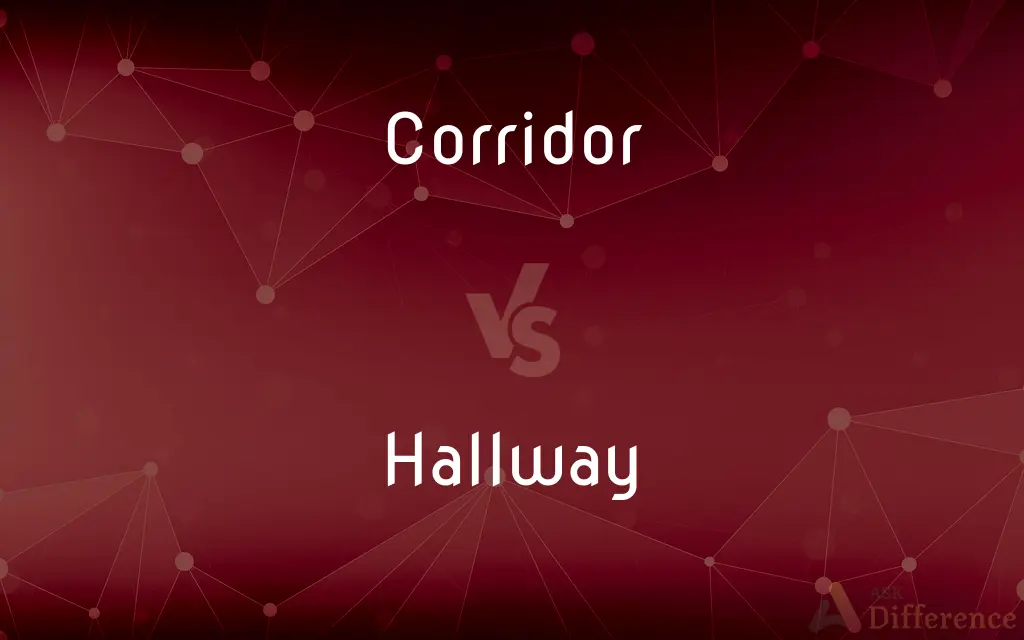Corridor vs. Hallway — What's the Difference?
By Tayyaba Rehman & Maham Liaqat — Updated on March 12, 2024
A corridor is a long, narrow passageway in a building, typically linking rooms, while a hallway serves as a broader path for circulation, often entrance areas.

Difference Between Corridor and Hallway
Table of Contents
ADVERTISEMENT
Key Differences
Corridors are designed as functional spaces in buildings, primarily used for movement between rooms or sections. They are often found in both residential and commercial buildings, facilitating access and providing a clear path for navigation. Whereas hallways, though similar in function, tend to be wider and may serve additional purposes such as housing furniture, decorations, or storage areas, reflecting a blend of utility and aesthetic appeal.
In terms of architecture, corridors are generally straightforward, emphasizing efficiency and the maximization of available space. They can be seen as purely transitional areas, with their design focusing on connecting different parts of a building. On the other hand, hallways often play a more significant role in the overall layout and design of a space, contributing to the first impression of an interior with their decor and arrangement.
From a usage perspective, corridors are typically utilitarian, offering a simple route from one place to another within a building. This makes them common in settings like offices, hospitals, and schools, where the primary need is for effective circulation. Hallways, however, can be more inviting and are sometimes used as galleries or display areas, adding character and warmth to a home or institution.
Lighting and ventilation considerations also differ between corridors and hallways. Corridors may have minimal natural lighting, relying more on artificial sources due to their functional nature and location within a building's interior. Hallways, especially in residential settings, might have windows or skylights, enhancing both the ambiance and air quality of the space.
Regarding their presence in building plans, corridors are often depicted as narrow, elongated spaces that maximize the efficiency of the layout by minimizing wasted space. Hallways, while also elongated, are generally planned with more generosity in width, allowing for a more comfortable passage and the possibility of decorative or functional additions to the space.
ADVERTISEMENT
Comparison Chart
Purpose
Primarily for linking rooms or sections
Serves as a circulation path, may house furniture or decorations
Width
Typically narrow
Wider than corridors
Usage
Utilitarian, for efficient circulation
Can be both functional and decorative, enhancing interior aesthetics
Common Locations
Offices, hospitals, schools
Residential homes, entryways
Design Focus
Efficiency and connectivity
Aesthetic appeal and comfort
Compare with Definitions
Corridor
A corridor is a narrow passageway between or within buildings.
The corridor led to a series of offices on the second floor.
Hallway
A hallway is a wide passage in a building, often the main entrance.
The house's hallway was decorated with family portraits.
Corridor
It is designed for direct access to different rooms.
The hotel's corridor was brightly lit, guiding guests to their rooms.
Hallway
It serves as a welcoming space and circulation area.
Their hallway had a small table for keys and mail.
Corridor
They are often utilitarian in design and decoration.
The corridor was lined with fire doors and emergency lighting.
Hallway
They are integral to the interior design and layout.
The hallway’s lighting and color scheme set the mood for the home.
Corridor
Corridors are functional spaces prioritizing movement.
The hospital's corridors were wide enough to accommodate gurneys.
Hallway
Hallways can enhance the functionality and aesthetics of a space.
The grand hallway led guests into the heart of the home.
Corridor
Corridors can be found in a variety of buildings.
The school corridor was bustling with students during the break.
Hallway
Hallways may accommodate furniture and decorative elements.
A bench and coat rack stood in the spacious hallway.
Corridor
A long passage in a building from which doors lead into rooms
His room lay at the very end of the corridor
Hallway
Another term for hall (sense 1 of the noun)
Corridor
A narrow hallway, passageway, or gallery, often with rooms or apartments opening onto it.
Hallway
A corridor in a building.
Corridor
A tract of land designated or used for a specific purpose, as for railroad lines, highways, or pipelines.
Hallway
An entrance hall.
Corridor
A route designated for a specific purpose
A hazardous material corridor.
A sea corridor for shipping.
A flight corridor.
Hallway
A corridor in a building that connects rooms.
Corridor
A route or tract of land used by migrating animals.
Hallway
An interior passage or corridor in a building, onto which rooms open.
Corridor
A thickly populated strip of land connecting two or more urban areas
People who live in the Boston-Washington corridor.
Hallway
An interior passage or corridor onto which rooms open;
The elevators were at the end of the hall
Corridor
A narrow hall or passage with rooms leading off it, as in a building or in a railway carriage.
Corridor
A restricted tract of land that allows passage between two places.
Corridor
The covered way lying round the whole compass of the fortifications of a place.
Corridor
Airspace restricted for the passage of aircraft.
Corridor
A gallery or passageway leading to several apartments of a house.
Corridor
The covered way lying round the whole compass of the fortifications of a place.
Corridor
Any relatively narrow passageway or route, such as a strip of land through a foreign territory.
Corridor
A densely populated stretch of land; as, the Northeast corridor, extending from Richmond, Virginia into Maine.
Corridor
An enclosed passageway; rooms usually open onto it
Common Curiosities
How do hallways differ from corridors in terms of design?
Hallways differ from corridors in that they are wider, can serve decorative purposes, and often contribute to the first impression of a space with their layout and decor.
How does the function of a corridor impact its design?
The function of a corridor as a passage for efficient movement influences its design to be more straightforward and narrow, focusing on connectivity and space optimization.
What is the primary purpose of a corridor?
The primary purpose of a corridor is to provide a straightforward, narrow passageway for efficient movement between rooms or sections within a building.
What makes a hallway inviting?
A hallway becomes inviting through its wider space, decorative elements, and potentially natural lighting, making it a welcoming area within a building.
How do lighting needs differ between corridors and hallways?
Corridors often rely on artificial lighting due to their functional nature and placement within a building, whereas hallways may benefit from natural lighting sources to enhance ambiance and visibility.
Are hallways always part of residential buildings?
Hallways are common in residential buildings but can also be found in commercial and institutional settings, where they serve as main circulation paths or entrance areas.
Can corridors have decorations?
While corridors are more utilitarian and focus on functionality, they can still feature minimal decorations such as art or signage, albeit less extensively than hallways.
Can both corridors and hallways serve as emergency exits?
Yes, both corridors and hallways can serve as emergency exits, though their designs must meet specific safety standards to ensure clear and accessible egress paths.
Can the design of a hallway impact a home’s overall aesthetic?
Absolutely, the design of a hallway can significantly impact a home’s overall aesthetic by setting the tone for the interior design and providing a space for decorative expression.
Is furniture common in corridors?
Furniture is not commonly found in corridors due to their narrow width and focus on efficient circulation, unlike hallways where furniture and decorations are more prevalent.
How do building codes affect corridor and hallway designs?
Building codes influence the design of corridors and hallways by setting standards for width, lighting, ventilation, and egress to ensure safety and accessibility.
What role do corridors play in commercial buildings?
In commercial buildings, corridors play a crucial role in organizing space and facilitating movement between areas, emphasizing efficiency and functionality.
Are there architectural styles where corridors or hallways are particularly emphasized?
In some architectural styles, such as modern or minimalist, the design of corridors and hallways can be particularly emphasized to align with the overall aesthetic and functional philosophy, showcasing simplicity and efficiency or spaciousness and light.
How do architects integrate hallways into building designs?
Architects integrate hallways into building designs by considering them as key elements of the interior layout, focusing on traffic flow, aesthetics, and the incorporation of natural light.
Do corridors and hallways have different widths?
Yes, corridors are typically narrower than hallways, reflecting their primary focus on efficient circulation versus the more multifunctional and decorative nature of hallways.
Share Your Discovery

Previous Comparison
Selfish vs. Greedy
Next Comparison
Organism vs. OrganAuthor Spotlight
Written by
Tayyaba RehmanTayyaba Rehman is a distinguished writer, currently serving as a primary contributor to askdifference.com. As a researcher in semantics and etymology, Tayyaba's passion for the complexity of languages and their distinctions has found a perfect home on the platform. Tayyaba delves into the intricacies of language, distinguishing between commonly confused words and phrases, thereby providing clarity for readers worldwide.
Co-written by
Maham Liaqat













































